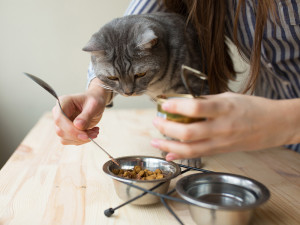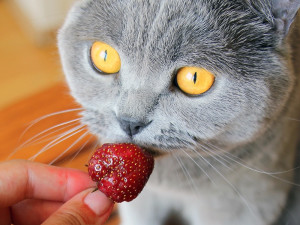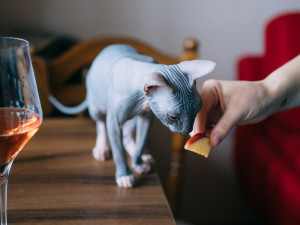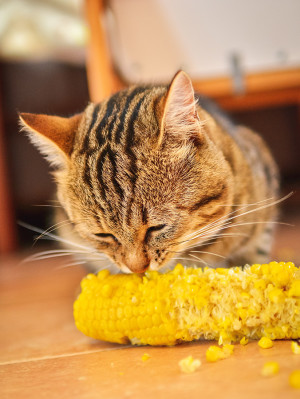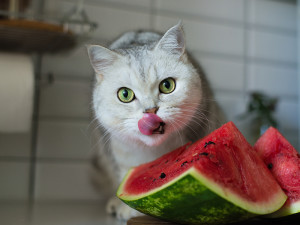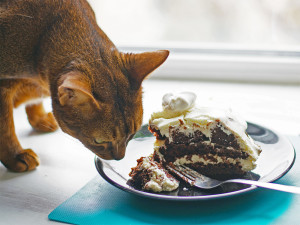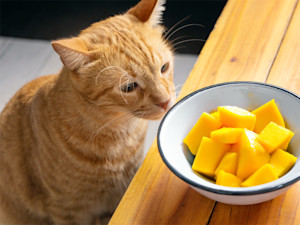Can Cats Eat Nuts?
Can you feed your cat nuts? Learn more about the benefits and risks of feeding your kitty human foods

Share Article
Nuts are the perfect snack for us humans when we feel the need to munch. The small crunchy salty treats (in moderation) are nutritionally dense and can be beneficial to our health, too. But have you ever wondered if your cat can enjoy the delicious treat, too? The good news is that yes, technically, cats can eat nuts (some of them), but just because you can feed your cat nuts, it doesn’t mean you should.
Nuts contain plenty of beneficial components, such as protein content and mineralsopens in a new tab. However, for our feline friends the benefits are outweighed by the not so useful components for their nutritional needs such as high fat content, and some risk factors such as being a choking hazard and additional ingredients that may be toxicopens in a new tab.

littleKin™ is Kinship’s home just for puppy and kitten parents. Bop over to check out expert advice, new pet tools, and special deals—all curated for your newest family member.
opens in a new tabMacadamia nuts, in particular, are dangerous to your pets as they are toxic. Let’s look into some of the reasons why it might not be a good idea to share any of your nutty snacks with your cat companions.
Can cats eat nuts?
Yes, most nuts are not toxic to cats. In fact there are treats available in nutty flavours designed just for cats, in particular, peanut butteropens in a new tab seems to be a flavour that cats generally enjoy. Cats are obligate carnivores meaning they have to have meat in their diet to meet their basic nutritional needs, and ideally they should have a lower carbohydrate portion to their diet. Cats are built for catching preyopens in a new tab such as mice and eating meat, so their normal jaw motions are mostly up and down with minimal grinding surfaces on their molars. This can mean small hard foods, such as nuts, may not be chewed easily and can present a choking hazard.
Are some nuts dangerous for cats?
There are some other issues to feeding nuts to cats as well as presenting a potential risk of choking, and that is in the form of toxicity and allergic reactions. Macadamia nuts are known to be toxic to dogs and while not documented in cats, they are thought to produce a similar effect, so it is best to steer clear of feeding macadamia nuts to pets at all.
Signs of toxicity include:
weakness
depression
ataxia (loss of coordination)
tremors
hyperthermia (high body temperature)
While other nuts are not toxic to cats it is still possible for animals to have allergic reactions to foods just the same as some humans do. If your cat has an allergic reaction, some signs to look for are vomitingopens in a new tab, diarrhoeaopens in a new tab, facial swellings, severe itching and hair lossopens in a new tab. If any of these signs are seen after ingestion it is best to seek veterinary care.
It is also not just the nuts themselves that present a risk to cats but what goes with the nuts. Snacks designed for human consumption also cater to our sweet tooth. We can enjoy chocolate covered nuts but these are dangerous to pets as the theobromine in chocolateopens in a new tab is toxic. Another risk to remember is the sweetener xylitol, which can be found in some nut butters, and so always check the ingredients for these things if considering feeding human treats to cats.
Are there any nutritional benefits for cats eating nuts?
Nuts contain many beneficial components such as a high quality protein content, polyunsaturated and monounsaturated fatty acids, vitamins E and K. They also contain many minerals such as magnesium, selenium, copper, potassium and possible antioxidant actions.
However, this doesn’t mean they are good for your cat's health. Nuts also contain a very high fat content which, when over-consumed, can lead to health problems. As discussed previously, nuts can also be mixed with potentially toxic ingredients for pets and also usually come flavoured or heavily salted. These added ingredients can be detrimental to your pet’s health and having too much salt in their diet can lead to future problems –especially for those cats already at risk of kidney issues.
What’s the best way to give my cat nuts?
If you want to add nuts into your cat’s diet, the best way is to only give them a small amount and stick to peanut butter or treats designed for pets in which the ingredients are known and shown. This way you know you aren’t creating an imbalance within their diet and risking future health concerns. If your cat has not had nutty treats before, remember to introduce new ingredients gradually and carefully keeping an eye out for any allergic reactions to unknown food.
What should I do if my cat eats nuts that are dangerous to them?
If your pet has ingested anything that may be dangerous such as macadamia nuts, chocolate-covered nuts or nutty butters containing xylitol sweeteners, the best thing to do is contact your vets. Depending on what and how much they have eaten, your vet may want to see your pet to induce emesis (make them sick) or give them treatment to reduce the absorption of toxic ingredients.
The bottom line: can cats eat human food?
There is a vast array of common foods that cats and humans share and enjoy the same way. Try to make sure the treats you give you cats suit their unique nutritional needs and not just what we enjoy. One interesting point is that cats don’t taste sweet things the way we do and if given the choice of sugared water versus plain water, they have no preference!
What they enjoy is the occasional snack in the form of meat, crunchy fruit or paste like a peanut butter or lick tube. Used sparingly, it can be a wonderful treat for them to enjoy or used as positive reinforcement for scenarios such as a vet visit or crate training.
The best diet for your cat is to have the majority of their diet based on a balanced and complete formulated meal to make sure all their essential nutritional needs are met. You can then add the occasional treatopens in a new tab, in human food or pet treat form, to make up less than 10 percent of their food intake. It is a great way to bond with your pet, and to be honest, who doesn’t enjoy a treat or two!
Human foods that are good for cats
If you are looking for healthy snack options to share with your cat, consider some of these:
Watermelonopens in a new tab can be a refreshing treat to share with your kitty.
Peanut butteropens in a new tab is high in protein and good fats.
Applesopens in a new tab are a great source of fibre and many important vitamins (although the seeds can be toxic ingested in large quantities).
Human foods that are dangerous to cats
Garlic is toxic to cats and can cause life-threatening anaemia.
Onions are toxic to cats and can cause fatal health complications.
Chocolateopens in a new tab is toxic to cats and can cause a range of health problems depending on how much is ingested.
Note: while caution was taken to give safe recommendations and accurate instructions in this article, it is impossible to predict an individual cat’s reaction to any food or ingredient. Readers should consult their vets and use personal judgement when applying this information to their own cats’ diets.
Frequently asked questions
How many nuts can a cat eat?
The majority of nuts are non toxic to cats except for macadamia nuts, these are dangerous to pets and should be avoided. Other nuts and nut butters can be enjoyed sparingly.
Is it OK to give cats nuts?
Nuts and nut butters should only be used as the occasional treat for cats as they are high in fatty acids and salty contents, which can unbalance their diet. They also have the potential to be a choking hazard, be sure to offer in small pieces or as a paste to minimise risk. And check ingredients for any other toxic components.
Why do cats like nuts?
Nuts can be delicious, crunchy nuggets of joy! And when given as a treat by a loved one it can be a curious delicacy. Anything you present as a treat to your pet has the potential to be enjoyed because it comes from you, so try to pick ingredients that are beneficial to include in their diet.
References

Dr Josephine Corrick, BVMSci, BSc, MRCVS
Dr Josephine Corrick, BVMSci, BSc, MRCVS is a veterinary surgeon based in the south of Scotland where she has been since graduating from the University of Surrey. She enjoys working in general practice treating small animals. Her particular interests include diagnostic imaging and the treatment of wildlife.
Having found a passion for veterinary medicine after doing a degree in Equine Sports Science she still enjoys including horses in her life by spending time with her highland ponies. Alongside her clinical work, she helps run a smallholding caring for rare breed sheep and exploring the Scottish countryside with her young Cocker Spaniel.
Related articles
![A gray Sphynx cat sniffing an apple slice held out by her owner while standing on a table next to a glass of wine]() opens in a new tab
opens in a new tabCan Cats Eat Apples?
Yes, but the fruit might not hold much a-peel
![an orange and brown cat nibbles corn on the cob]() opens in a new tab
opens in a new tabCan Cats Eat Sweetcorn?
A few kernels won’t hurt, but think twice before doling out a bowl of the stuff
![White kitten with tongue out next to slices of watermelon]() opens in a new tab
opens in a new tabCan My Cat Safely Enjoy Watermelon?
Yes, the summertime staple is on the list of safe foods for cats
![a cat stares at green grapes on a plate]() opens in a new tab
opens in a new tabCan Cats Eat Grapes?
This is one you’ll want to bookmark
- opens in a new tab
Can Cats Eat Chocolate?
The human favourite should be kept far away from kitties
![Orange cat sniffing cut up mango fruit.]() opens in a new tab
opens in a new tabCan Cats Eat Mango?
It is the perfect healthy treat for you, but what about them?


